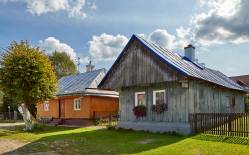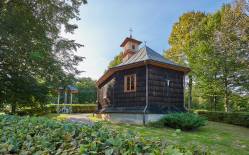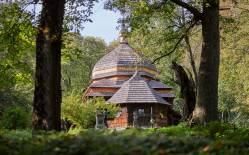Mrzygłód today is a picturesque holiday village upon the river San. In 1425 King Władysław Jagiełło appointed Matiasz of Zboiska with the mission to establish a town, based on Magdeburg law. The townspeople were awarded the right to hold two trading fairs a year and weekly markets, according to the custom adopted in the towns of Sanok and Krosno.
The earliest record of the local Roman Catholic parish dates from 1410. The Church of the Sending Out of the Apostles, which can still be seen here today, was built in 1424. This means it is the oldest church in the Sanok District. The local residents showed their gratitude to King Władysław Jagiełło by building his monument in the main square. Its reconstruction after the war was not very successful and the local people used to call him “the king in felt boots”. Some time ago the awkward sculpture was replaced with a new work of art. Over its long history the town was haunted by various calamities such as fire, Tatar hordes and Rákóczi’s divisions.
The new name of the town – Mrziglod – for the first time appears in the records in 1616 in place of the old name – Tyrawa Królewska. According to the local tradition the name was changed into Mrzygłód (meaning “deadly famine”) because of the epidemic of typhus in the 1600s caused by harvest failure, and resulting in death of many local people. Mrzygłód retained the status of a royal town until 1772. It lost its municipal rights in 1955.
Mrzygłód was once famous for its ceramic products. The local pottery traditions continued until the mid-1900s. Many inhabitants of Mrzygłód working as bargemen used to float such goods as salt, wood, tar and ceramic products. Furthermore, craftsmen of nearly all specialties worked here. In the early twentieth century oil drills were built at Kikowa Góra. According to one hypothesis the stream bed of the San changed its course around 1430 as a result of which the place was divided into two settlements corresponding to today’s Mrzygłód on the right, and Tyrawa Solna on the left bank of the river.
Today we can admire the Medieval layout of the old quadrilateral town square paved with stone, and in the middle traversed by the Iłna stream. It is surrounded with log houses, from the 1800s or early 1900s, standing in rows and facing the square with their front walls or gable ends. Not far from the main square we can see the parish church mentioned earlier.
In 2019, the “San Valley” Local Action Group launched a workshop of vanishing crafts in a restored building located in the main square.
Photo: Krystian Kłysewicz
Gallery

Recommended venues on the Trail







This website has been modernized with the financial support of the European Union under the Cross-Border Cooperation Programme Poland-Belarus-Ukraine 2014-2020. The responsibility for its content lies solely with the Podkarpackie Regional Tourism Board and cannot, in any case, be treated as a reflection of the position of the European Union, the Managing Authority, or the Joint Technical Secretariat of the Cross-Border Cooperation Programme Poland-Belarus-Ukraine 2014-2020.









